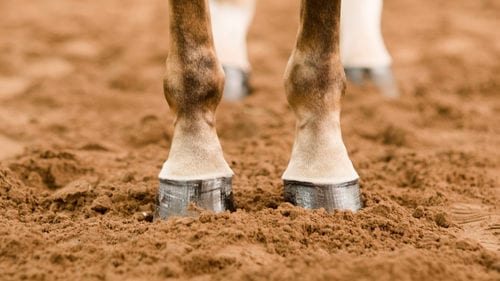“No hoof, no horse,” – the overused yet powerful statement that we all can attest to. For a horse to perform, or even live a healthy life, it must have healthy hooves.
As horse owners, it is our job to keep our horse’s feet in top shape. You cannot expect maximum performance out of your partner without proper hoof care.
GoHorseShow spoke with two successful farriers, Kenny Hall and Barry Capps, about the inside tricks to making your horse’s hooves healthy and ready to go for the show ring.
Farriers
Keeping your horse trimmed and shoed is very important. “The four to six-week period stays true for pretty much every horse,” says Capps.
By doing this, you are preventing overgrowth and splitting. “In the summer months, horse’s feet tend to grow faster, therefore, you would increase them to a four to five-week schedule instead of a good six-week cycle for winter months,” says Hall.
“All horses are different, though,” explains Capps. It is essential to develop a good relationship with your farrier to make a routine specific to your horse.
Nutrition
Grow your hooves from the inside out. “Nutrition is so essential for the health of a horse’s feet. It is what makes them strong, resilient, and manageable,” says Capps.
He also explains how carbohydrates play a role in hoof health. “You ideally want a horse to be provided with a feed that has a sugar and starch count of 10% or under.”
A carb overload can make the hooves dry and brittle. As for forage, horses eat most of their weight in grass and hay.
“Whether your horse is turned out 24/7 or in the stall for most of the day, make sure they have access to some form of grass,” says Hall. Hay and grass provide many vitamins and minerals that allow for proper hoof growth.
Moisture
A good hoof is not too dry and not too wet. The perfect moisture balance in a foot is hard to achieve, but not impossible.
“When you turn them out in the night or early morning, there is a lot of dew on the ground that can cause the hoof to become overly wet,” states Capps.
He suggests pasture time be during the day if you keep your horse stalled part of the time. “They do need some moisture, though. Getting their feet wet when you are spraying them off is a good way to accomplish this. I like to wet my stalls, not soak them, just a light spray, to get an even, good amount of dampness to the feet,” says Hall.
Dressings
“There are so many good hoof dressings out there,” states Capps. You can find these dressings at feed stores, online, and even commercial businesses.
These smears are usually applied a couple of times a week to either add moisture to the hoof around the cornett band or seal the sole.
However, you can find dressings that address different issues as well. “People have to understand that dressings and supplements take a while to show a benefit. A horse only grows a new hoof after a year or more. It takes a while to see results,” explains Hall. So, do not get discouraged, be patient, and follow the instruction of your farrier.
Education
The best thing for a horse owner to do is to educate themselves,” says Hall. Be aware of what is going on with your horse. You might not be an expert, but you should be able to see what is right and what is wrong. “Most people are at the mercy of the farrier,” states Hall.
If you ask questions, observe professionals, and pay attention, you will see what is going on with a clearer view. “You do have to be careful about what you find on the Internet, though,” says Capps. “You can find some very wrong stuff on there.”
Overall, find what is normal for your horse and talk to your farrier about what is best to keep that routine consistent.
Hoof care looks different for every horse. “Every horse is an individual. There is no black and white answer to hoof care. You have to evaluate each horse,” says Capps.
A horse owner’s job is to pick out the feet daily, check for signs of abnormalities, and create a good relationship with a farrier. “Your farrier can guide you in the right direction,” says Hall.









